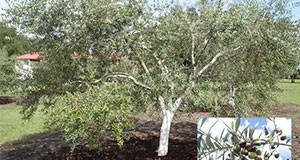Abstract
Olives have great potential as a landscape ornamental and may also provide opportunities for home fruit production. However, as a relatively new commercial crop to Florida, the cultural requirements of these trees are not completely known and research is ongoing to understand how to manage them for plant health and fruit yield as well as to make recommendations on varietal selections best suited to the southeastern region of the United States. This 5-page fact sheet includes culture and management information, selected references, and a table listing a selection of olive cultivars currently available in the U.S. It was written by Mack Thetford, Jennifer L. Gillett-Kaufman, Michael J. Mulvaney, and published by the UF Department of Environmental Horticulture, February 2015.
Minor Revision December 2017.
References
Cuevas, J., A. J. Díaz-Hermoso, D. Galián, J. J. Hueso, V. Pinillos, M. Prieto, D. Sola, and V. S. Polito. 2001. "Response to Cross-Pollination and Choice of Pollinisers for the Olive Cultivars (Olea europaea L.) 'Manzanilla de Sevilla', 'Hojiblanca' and 'Picual'." Olivae 85:26-35.
Cuevas, J, V. Pinillos, and V. S. Polito. 2009. "Effective Pollination Period for 'Manzanillo' and 'Picual' Olive Trees." Journal of Horticultural Science and Biotechnology 84:370-374. https://doi.org/10.1080/14620316.2009.11512534
Diaz A, A. Martin, P. Rallo, D. Barranco, and R. De La Rosa. 2006. "Self-Incompatibility of 'Arbequina' and 'Picual' Olive Assessed by SSR Markers." Journal of the American Society for Horticultural Science 131:250-255. https://doi.org/10.21273/JASHS.131.2.250
Farinelli, D., P. Pierantozzi, and A. M. Palese. 2012. "Pollenizer and Cultivar Influence Seed Number and Fruit Characteristics in Olea europaea L." HortScience 47:1430-1437. https://doi.org/10.21273/HORTSCI.47.10.1430
Fernández-Escobar, R. and G. Gómez-Valledor. 1985. "Cross-Pollination in 'Gordal Sevillana' Olives." HortScience 20:191-192.
Guerin J. and M. Sedgley. 2007. Cross Pollination in Olive Cultivars. Barton, Australia: Rural Industries Research and Development Corporation. Publication No 07/169.
Sánchez-Estrada, A. and J. Cuevasb. 2018. 'Arbequina' olive is self-incompatible. Scientia Horticulturae. 230:50-55. https://doi.org/10.1016/j.scienta.2017.11.018 https://doi.org/10.1016/j.scienta.2017.11.018
Seifi, E., J. Guerin, B. Kaiser, and M. Sedgley. 2012. "Sexual Compatibility of the Olive Cultivar 'Kalamata' Assessed by Paternity Analysis." Spanish Journal of Agricultural Research 10(3):731-740. https://doi.org/10.5424/sjar/2012103-501-11

